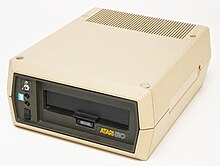
Frequency modulation encoding, or simply FM, is a method of storing data that saw widespread use in early floppy disk drives and hard disk drives. The data is modified using differential Manchester encoding when written to allow clock recovery to address timing effects known as "jitter" seen on disk media. It was introduced on IBM mainframe drives and was almost universal among early minicomputer and microcomputer floppies. In the case of floppies, FM encoding allowed about 80 kB of data to be stored on a 5+1⁄4-inch disk.
IBM began introducing the more efficient modified frequency modulation, or MFM, starting in 1970. They referred to this format as "double density", with the original FM retroactively becoming "single density". MFM was more difficult to implement and it was not until the early 1980s that low-cost all-in-one MFM floppy drive controllers like the WD1770 emerged. This led to the rapid demise of FM encoding in favor of MFM by the mid-1980s.